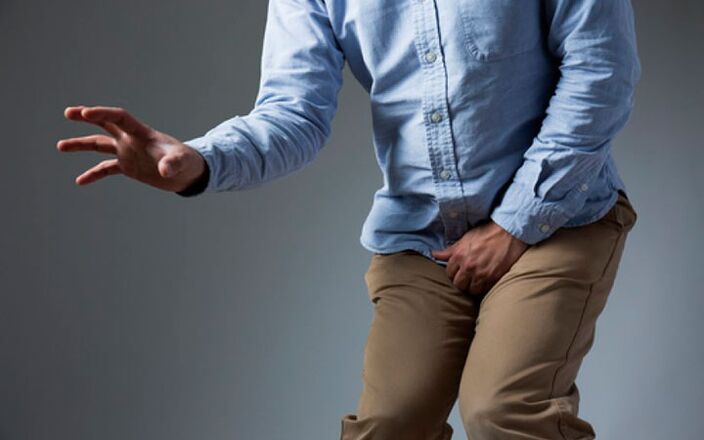Prostatitis can affect potency or cause infertility. The success of treatment largely depends on how quickly treatment is started, therefore a man must independently pay attention to the first signs. Consider how prostatitis manifests itself in acute and chronic forms, as well as provide information on clinical manifestations and symptoms.

Signs of acute and chronic prostatitis
Acute prostatitis most often occurs in men of sexually active reproductive age. The first signs of the disease in this case appear unexpectedly, develop rapidly and go unnoticed.
With acute prostatitis, a man will feel:
- sharp, often throbbing pain in the perineum;
- temperature rise to 39 ° C;
- pain when urinating.
With disease, the focus of inflammatory processes in the prostate gland is wide, therefore, nearby organs may be involved in pathological processes. For example, prostatitis can affect the rectum, resulting in painful bowel movements.
Chronic prostatitis is more frequently diagnosed in men of retirement age. The disease can proceed without any special symptoms. Sometimes patients complain to the doctor about burning or itching when urinating, noticing mucus or purulent discharge from the penile glands. Pain in chronic prostatitis is either absent or insignificant, and the temperature rises to 37 degrees.
Early symptoms
Doctors identify several manifestations that are considered signs of the disease. They are a signal for a man to visit a doctor in the near future. The six symptoms listed below indicate problems in the genitourinary system and are therefore combined into one group - dysuric syndrome:
- Urine is excreted in drops, the man strives for this.
- The jet is damp, the distance is not more than 20 cm.
- Inadvertent splashes of urine, rupture or flow disturbances.
- Often urged to use the toilet at night.
- Pain during urination.
- Taste where the urine is empty.
If there is only one symptom - prostatitis, most likely, we are not talking. However, if a man can notice two or three signs in himself, this is a reason to consult a doctor. Most likely, the inflammatory process has already begun in the prostate.

The doctor will make a more accurate diagnosis after rectal examination, TRUS, laboratory methods, which together form a comprehensive examination. Based on the results of these measures, treatment is also selected, therefore self-medication is strictly prohibited.
Problems with urination may indicate prostate cancer, so therapy tactics will be fundamentally different.
Certain manifestations do not always indicate prostatitis; they may indicate any other inflammatory process in the genitourinary system. However, when they do appear, there is reason to be careful. Consider how a man would feel if he had inflammation of the prostate.
Urinary incontinence
In patients with acute prostatitis, the process of urination is disturbed. Typically, a man can feel up to 15 urges to relieve small daily needs, this is due to the drinking regimen. The average indicator - 4-5 times. However, with prostatitis, the picture changes. A man may feel cravings twice as often, but the amount of urine will not increase. This means the kidneys are functioning smoothly, but the bladder wall is compressed by the prostate.
Narrowing of the prostate urethra causes stranguria. This is a pathological condition in which a man feels severe pain when urinating. The development of ischuria is also possible (inability to go to the toilet).
Increased temperature
The first sign of acute prostatitis will be an increase in temperature to the level of fever (38-39 degrees). These symptoms are primarily characteristic of purulent prostatitis and are a sign of septic shock. When a severe infectious process takes place, the body temperature can drop to 35-36 ° C.
In some cases, this condition can be life threatening. It is especially dangerous for men with disseminated intravascular coagulation syndrome.
Appearance of blood in urine
These symptoms are more frequently detected in urine laboratory studies, less frequently visually by the man himself. This is a dangerous manifestation of prostatitis, which is very difficult to fight. The cause of hematuria (scientific name of the nature) can be:
- location of blood vessels in the area of purulent-inflammatory process;
- development of prostate cancer or adenoma;
- trauma to the urethra or prostate during examination.
Also, such a manifestation is possible with calculus prostatitis, when stones and sand damage the glandular tissue. Fortunately for men, hematuria with prostatitis is very rare.
Thigh pain syndrome
Acute prostatitis, as well as cases of complications in the chronic form, can be accompanied by different pains, from moderate to severe. This is not the first sign of prostatitis, but it should not be ignored. The following types of discomfort are distinguished:
- shooting, sharp pain;
- pain or pressing;
- itching and burning (more often with chlamydial prostatitis).
In some cases, men may also feel pain in the anus. It increases with bowel movements, in a sitting position, and disappears if the man rests.
Laboratory signs of disease
It is possible to say that a man has started prostatitis only after laboratory tests of blood and urine, as well as according to the results of ultrasound, CT, MRI and palpation. There are several known signs that make it possible to establish inflammation in the organs:
- the appearance of leukocytes in the blood and urine;
- identification of pathogenic microflora in urine and prostate secretions;
- an increase in the number of leukocytes against the background of a decrease in the number of lecithin grains in prostate juice;
- pain in the prostate area during rectal examination;
- an increase in gland size on TRUS images, the presence of areas with increased echogenicity.
Also, the presence of inflammation in the body can be assessed by other parameters - an increase in ESR in blood tests, a shift in the leukogram, the presence of immobile sperm in ejaculation.
Various bacteria can be found in urine - Trichomonas, chlamydia, E. coli, etc.
Instead of instrumental methods, in addition to TRUS, X-ray examination with contrast may be involved. In pictures of the prostate in different projections, signs of inflammation will be clearly visible - areas with disruption of tissue structure.
Conclusion
From a practical point of view, the following first signs of prostatitis are important for a man - a violation with urination and pain in the perineum. If the temperature rises at the same time, we can talk about acute bacterial prostatitis.
In any case, you need to make an appointment with a doctor, undergo an examination and just start treatment. It is forbidden to choose your own therapy, focus only on unpleasant manifestations.
























